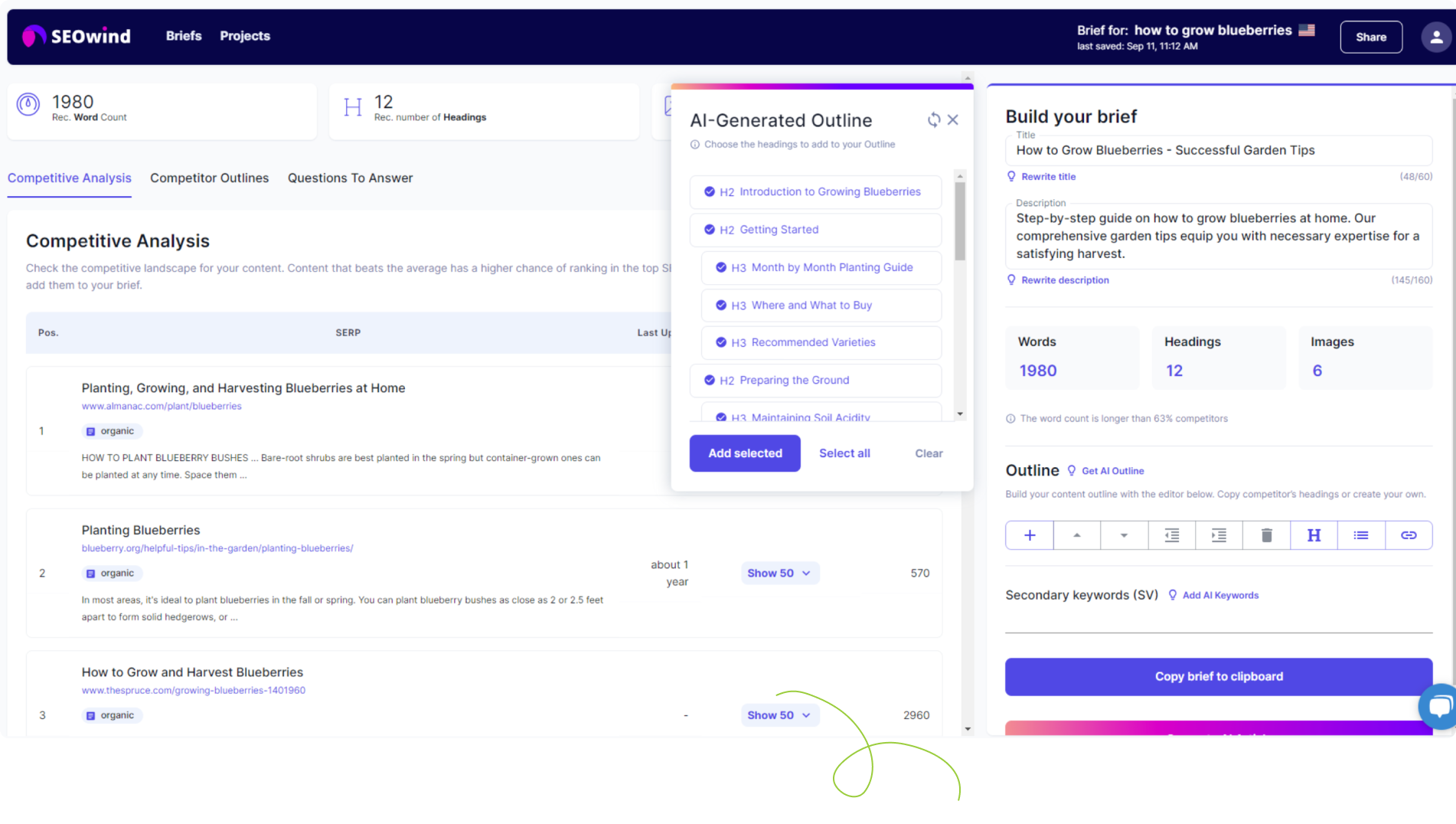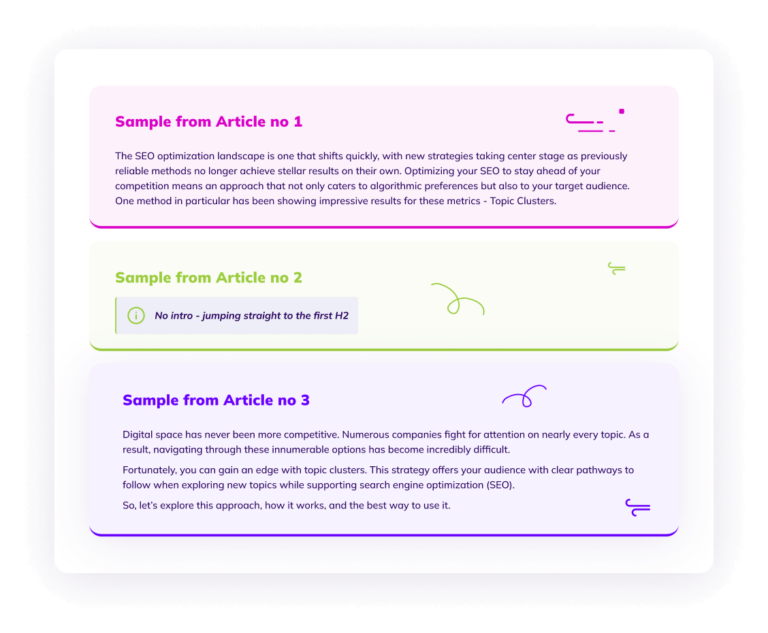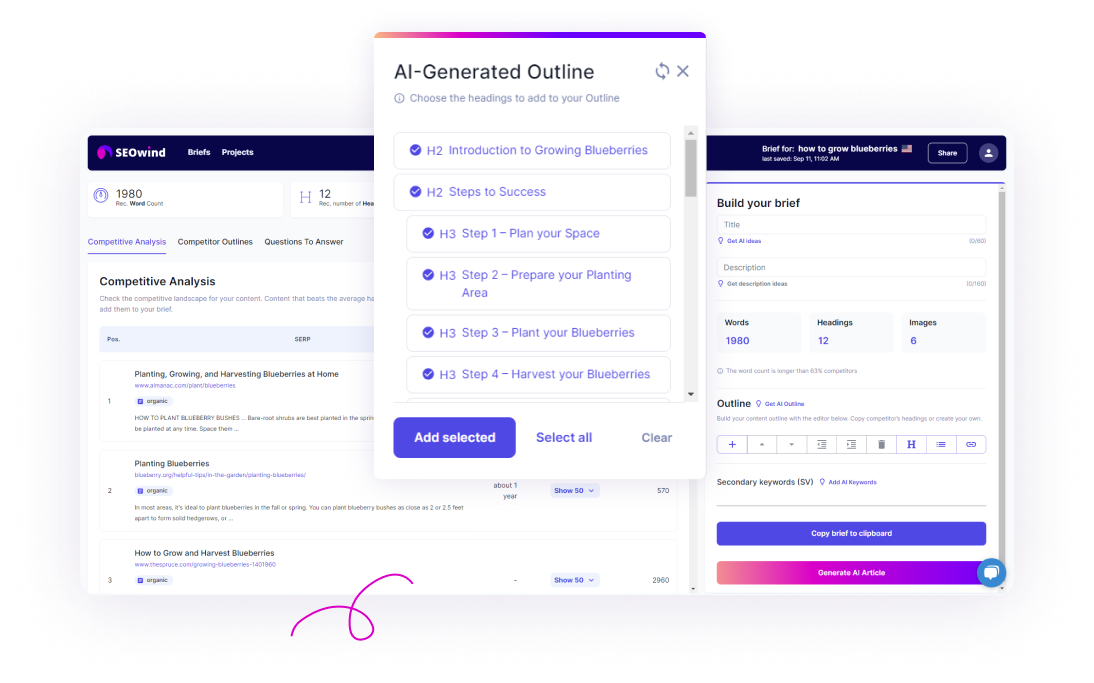Compare and guess who wrote what
Human vs AI written content
Wondering what results you might get when scaling content with AI? We’ve decided to check it out. Below you will find all the details of the whole journey.

Why behind the experiment
Introduction
Everywhere we look
there’s a conversation about Artificial Intelligence (AI) content.
Can AI content match up to or even surpass human writing? Is it better or worse than human-written content? Critics argue that AI content lacks the brand voice and authenticity that only a human touch can provide. Some even claim it’s easier to create from scratch than to edit a piece produced by AI.
These are questions sparking debates across the web, and they caught our attention.
So, we decided to step out of the discussion and put the matter to the test.
Our goal? To determine if AI content stands up to the credibility tests, demands of time, and quality that set the standard for human content?
Let’s find out.

Our approach
#1 The AI vs Human Content Experiment description
The following section describes an experiment to compare the efficacy
and quality of content produced by human writers and artificial intelligence.
Inside, you’ll find details about the topic chosen for the experiment, the selection of authors,
and the carefully designed briefing to ensure a balanced competition.
Topics
In our AI versus Human content experiment, we zoomed in on a subject close to home: content clusters. This niche is a comfortable playground for our human copywriters, both of whom come with substantial experience in the marketing sector.
This allows us to analyze the output where human writers can leverage their expertise against AI-generated content that utilizes advanced machine learning techniques.

Briefing
The level playing field was critical. We created a detailed content brief with clear guidelines to ensure fair play. Each participant received the same brief, including:
- article title,
- a comprehensive outline to navigate by,
- a list of focus and secondary keywords to hit,
- and instructions on the desired tone of voice.
To cap it off, we made sure they knew the suggested article length, the SEO title, and the meta description they needed to craft.
For the sake of the experiment, we limited the word count to 2,000 words. This length is enough to cover the topic and compare the article’s quality. Still, as the topic is broad, the content should likely be longer to give it a better chance to rank.
Who wrote the articles
Three Authors
Three distinct authors were enlisted for this experiment, each bringing a unique perspective.
Author X
Author Y
Author Z
Below, you can find a content brief:
Master Topic Clusters for Superior SEO Results
SEO title: Master Topic Clusters for Superior SEO Results
Meta Description: Want better SEO outcomes? Discover how topic clusters can revolutionize your web visibility and improve site traffic. Read on and boost your SEO today!
Article guidelines:
Focus keyword: topic clusters (SV: 720)
Secondary keywords:
topic clusters (SV: 720), topic clustering (SV: 90), topic cluster content strategy (SV: 50),
topic cluster model (SV: 30), topic cluster strategy (SV: 30)
seo topic clusters (SV: 140), topic clusters seo (SV: 90)
what is a topic cluster (SV: 110), what are topic clusters (SV: 90), what is the topic cluster model
(SV: 30)
content clustering (SV: 90), content cluster (SV: 90)
topic cluster and pillar pages (SV: 70), topic clusters and pillar pages (SV: 70)
how to create topic clusters (SV: 20)
Suggested article length: 2000 words
Note: Please don’t use AI when writing the article.
[this part was a part of brief for human writers]
Tone of voice:
The brand’s voice is informative and authoritative, with a conversational and slightly informal tone. The style leans towards story-telling, using metaphors to explain complex ideas. The language is straightforward yet intelligent, aiming to educate the audience while engaging them through explorative narration. Essentially, this brand communicates as an insightful guide taking readers on a journey of understanding. Its tone is reassuring and supportive, fostering user confidence. The brand’s style encapsulates clear, direct, empathetic communication. It manifests practicality with a detailed, instructive approach enhanced by vivid examples, while encouraging active engagement with questions and actionable suggestions.
Article outline:
H2 – What are Topic Clusters?
H2 – The Benefits of using Topic Clusters
H3 – Increased search engine visibility and organic traffic
H3 – Better user experience and engagement on your website
H3 – Higher chances of ranking for multiple keywords and search queries
H2 – Understanding the basics of Topic Clusters
H3 – The concept of pillar content
H3 – Cluster content and its role within topic clusters
H3 – The significance of internal linking in topic clusters
H2 – How to create an effective Topic Cluster strategy
H3 – Step 1: Identify a core pillar topic for your cluster
H3 – Step 2: Conduct keyword research to find related subtopics
H3 – Step 3: Organize your content into pillar pages and cluster content
H3 – Step 4: Strategically link your cluster content to the pillar page
H3 – Step 5: Optimize your content for search engines and user experience
H2 – Measuring the effectiveness of your Topic Clusters
H3 – Key performance indicators (KPIs) to track for success
H2 – Key Takeaways on the future of topic clusters in SEO
Order details
#2 Cost and Turnaround Comparison
To keep it transparent, below you can find details concerning cost, estimated time spent on writing the article, and article turnaround.
Cost
Time spent on wriitng the article
Turnaround
Author X
Author Y
Author Z
Let’s see the articles
#3 Article samples from all the authors
For ease of comparing the articles, we are providing the same sections below and showing how the authors handled them.

The authors followed the same outlines, so the section order is coherent between articles.
Look at each article’s introductions, body copy, and conclusions of each draft. I won’t reveal the authors until the end.
Here we go.
Introduction comparison
Sample from Article no 1
The SEO optimization landscape is one that shifts quickly, with new strategies taking center stage as previously reliable methods no longer achieve stellar results on their own. Optimizing your SEO to stay ahead of your competition means an approach that not only caters to algorithmic preferences but also to your target audience. One method in particular has been showing impressive results for these metrics – Topic Clusters.
Sample from Article no 2
No intro – jumping straight to the first H2
Sample from Article no 3
Digital space has never been more competitive. Numerous companies fight for attention on nearly every topic. As a result, navigating through these innumerable options has become incredibly difficult.
Fortunately, you can gain an edge with topic clusters. This strategy offers your audience with clear pathways to follow when exploring new topics while supporting search engine optimization (SEO).
So, let’s explore this approach, how it works, and the best way to use it.
1st Body copy comparison
Sample from Article no 1
H2 – The Benefits of using Topic Clusters
The reason behind the shift to topic clusters is twofold:
Technical benefits: what we’re currently seeing is a change in the algorithm for major search engines such as Google to prioritize topic-based content. Google and other search engines rank sites more highly if they display expertise and trustworthiness around a particular topic, in fact Google has even gone so far as to develop a topic authority system for more sensitive content such as breaking news.
Customer needs: organizing content in this way will make your site more customer-centric. Organizing your pages into topic clusters will make them more intuitive to explore and will allow you to plan out materials that follow along the customer journey. Rather than pushing out one-off pieces of content that might or might not be loosely related, the topic cluster model will allow customers to deep dive into a specific focus area, making them more likely to engage with more of your pages and to consider you a subject matter expert.
H3 – Increased search engine visibility and organic traffic
The way search engine algorithms rank pages has already been overhauled several times in the past and it’s vital to keep up to date on these changes to pull more organic traffic to your pages. Updating your website structure and content strategy to the topic cluster model will help you to take advantage of the latest changes and bring more visibility to your website.
Sample from Article no 2
H2 – The Benefits of using Topic Clusters
A good strategy is where you and your e-commerce outlet or website receive something valuable from those strategies. When you apply a topic cluster content strategy then your e-commerce store or website should receive the following benefits.
H3 – Increased Search Engine Visibility And Organic Traffic
This is one of your SEO goals, or it should be. To facilitate this objective you need to plan a good topic cluster strategy. The reason you go to all this work is because it helps search engines understand your web pages’ overall themes and then rank those pages better.
A good topic cluster strategy also helps those search engines index your website better which in turn helps to improve your rankings. The better the ranking, the more visibility you get.
Then with the higher visibility and ranking, the greater chance your website has of gathering organic traffic. In the ever-changing SEO world, it pays to utilize every strategy that will not land you in search engine jail.
Sample from Article no 3
H2 – The Benefits of Using Topic Clusters
By adopting a topic cluster content strategy, you’re preparing your website to deliver enhanced SEO results. For example, Tao Digital Marketing, reports that by focusing on one topic cluster they managed to increase their client’s leads by 384% in six months, impressions by 137%, and clicks by 411% (Source: Moz Blog).
Let’s take a look at how exactly topic clusters make such an impact.
H3 – Increased Search Engine Visibility And Organic Traffic
First off, let’s talk about search engine visibility. Implementing topic clusters transforms your site’s architecture into a well-organized library instead of a messy stack of individual pages. This allows search engines like Google to decipher site themes more easily, making the most out of valuable positions on search engine result pages (SERPs).
This approach boosts visibility because it helps highlight semantic relationships between various pieces of content clustered around a common theme or subject. As Google becomes better attuned to the context of your content, your web pages will start appearing more frequently and, as a result, for more nuanced searches. Topic clusters make it easier for search engines to identify your expertise, experience, authoritativeness, and trustworthiness (the basis of the E-E-A-T model). As a result, organic traffic increases proportionally.
2nd Body copy comparison
Sample from Article no 1
H2 – How to create an effective Topic Cluster strategy
Now that we’ve established what topic clusters are and how to set them up, let’s dive deeper into how to build the topic cluster strategy. This will require a shift of thought from how you may have previously been working. Instead of thinking about individual keywords and content ideas, the topic cluster strategy is all about grouping related pieces together.
H3 – Step 1: Identify a core pillar topic for your cluster
Identifying core pillar topics for your cluster is key and you should start by brainstorming how you want to present your content:
- Which topics are more important for your brand?
- What’s the most relevant for your customers?
- What areas do you want to compete in most?
- Where are you considered an expert?
- Where would you LIKE to be considered an expert?
If we’re thinking about the cooking website, for example, are your customers typically more curious about searching for meals of the day as mentioned earlier, or do they more often ask about specific cuisines? Splitting it by breakfast, lunch, dinner, and dessert versus Mexican, Mediterranean, Asian, or French dishes would be equally valid options – consider what content you already have, what the needs are for your target audience, and what your competitors are producing.
Connecting everything back to your business strategy is going to help you shape how you want to build everything out. Don’t lose sight of the big picture, always keep these goals in mind when you’re laying out your structure.
H3 – Step 2: Conduct keyword research to find related subtopics
The content pages should answer customer questions within that topic. Going back to the example of the cooking website, you could explore what kinds of things users are usually looking for when they search for “breakfasts”. You could build subpages such as “healthy breakfast ideas for busy families”, “what’s the best way to prepare a scrambled egg”, or “5 must-have kitchen gadgets for the perfect home breakfast experience”. Use tools such as SEOWind or SEMrush to find those specific keywords and topics that people search for the most and build that into your topic cluster content strategy.
Sample from Article no 2
H2 – How to create an effective Topic Cluster strategy
H3 – Step 1: Identify a core pillar topic for your cluster
Before you can build a topic cluster, you need to pick a topic to write about. The topic will be one that you are interested in or one that relates to the products you are selling.
Once you pick a topic, you need to construct it in a way that it focuses on a single topic while leaving room for additional content related to that topic. To write this pillar page you need to focus more on topics than keywords.
One of the keys to writing your pillar page is to be broad enough to generate subtopics. A pillar page is no good if it has nowhere to link to.
H3 – Step 2: Conduct keyword research to find related subtopics
Once you have step one formulated it is time now to proceed with your keyword search. It is essential to use keywords to help you find relevant subtopics that will build your website’s credibility and authority.
The key to success in finding keywords for subtopics is to use general keywords not specific ones in your searches. For example, the keywords ‘personal injury lawyers’ will produce a multitude of subtopics while the phrase ‘personal injury lawyers for prisoners’ will not produce that many.
How you structure your initial keywords will determine the results you will get. You can also use questions in your searches to facilitate a good subtopic result.
Sample from Article no 3
H2 – How to Create an Effective Topic Cluster Strategy
Now that we’ve established what topic clustering is and how it works let’s analyze how we can use topic clusters more effectively.
H3 – Step 1: Identify a Core Pillar Topic for Your Cluster
Identifying a core pillar in your topic cluster strategy outlines the information you intend to convey and what you intend to accomplish.
When choosing your pillar, think about the following:
- Broad appeal – A good pillar should capture a significant aspect of what you wish your audience to know about you.
- Topical authority and proficiency – Opt for a topic within your realm of expertise for which you can provide exceptional and comprehensive content.
- Relevance and market demand – It helps if people want information on these themes, so ensure they’re valuable to potential visitors.
For example, let’s consider the Coffee Brewing Guides page from Coffee and Check. To support its objective of selling coffee-making supplies, the company demonstrates the different ways to brew coffee.
Remember, without an effective foundation, our neighborhood can’t function properly.
H3 – Step 2: Conduct Keyword Research to Find Related Subtopics
Like the Federation exploring new space in Star Trek, keyword research helps identify ideas that are closely related to your core issue but differ enough to work as unique pieces of content. Those are your subtopics!
A few golden rules:
- Use keyword tools such as Google’s Keyword Planner (free), Semrush (paid), and Ahrefs (paid). Explore Google Autocomplete to find out what people are searching for in relation to your pillar content.
- Look for search terms directly related to your pillar but only tangentially. They’re members of the same family, but not twins.
- Pick phrases that receive substantial search volume and for which you can still compete.
Coffee and Check’s pillar page utilizes phrases like “coffee brewing method,” “coffee brewing guide,” “brew the perfect coffee,” “Chemex” or “Aeropress.”
Now armed with your list of keywords, start producing specific yet authentically interconnected cluster content.
Key Takeaways
Sample from Article no 1
H2 – Key Takeaways on the future of topic clusters in SEO
Reorganizing the content on your website can seem to be a daunting task, as it requires you to put in much more effort upfront to build the foundation that the rest of your website can use to grow in the right way. The benefits of doing this, however, are extremely clear from both the technical and the customer standpoints as the market has continued to develop and optimize.
The shift to topic clusters is undeniably the next evolution of search engine optimization, so getting on board sooner rather than later will help you keep pace with your competitors. It’s vital to stay on top of the changes in terms of both the search engine algorithm as well as the customer expectations to stay relevant in the market and keep ahead of your competitors.
Sample from Article no 2
H3 – Key Takeaways on the future of topic clusters in SEO
- This is a strategy that helps your website build in-depth, valuable content on a core topic.
- Make sure your topic is broad enough to be used with a pillar page and cluster content.
- There are many benefits to using a pillar page and topic clusters. Some of those benefits include better visibility, improved user experience, more in-depth content, increased authority, and a more organized website.
- Make sure to optimize the pillar page and cluster content for search engines.
- Use a variety of KPIs when monitoring to ensure you are getting an accurate picture of your strategy’s success.
Sample from Article no 3
H2 – Key Takeaways on the Future of Topic Clusters in SEO
Topic clusters are here to stay. They’re not a fleeting trend but an integral part of the modern web structure.
First, let me highlight again that topic clusters are pivotal to achieving organic digital visibility. Search algorithms continue to evolve and understand user intent and relevance more effectively. They’re shifting from recognizing keywords to topics, which helps form a comprehensive understanding of what users seek online. Using topic clusters bases your website’s structure on communicating broader themes, which more effectively engages your audience.
In essence, traditional keyword optimization on its own is already outdated. Google now relies more on semantic searches and contextual relevance. Therein lies the power of topic clusters, which provide abundant context.
Furthermore, long-tail keywords become even more significant as voice search technology continues its upward trajectory through technology like Alexa and Siri. What does that mean for us exactly? Mostly, a well-structured topic cluster strategy capable of capturing such conversational queries is more important than ever.
Finally, remember that quality trumps quantity in today’s SEO playbook. With the growing preference for deeply informative content over superficial clickbait material, topic clusters allow you to delve deeper into specific areas in your field, which inspires closer examination of your expertise and fosters excellent user engagement.
Crafting high-quality pillar pages complemented by valuable cluster content will be a decisive factor that shapes next-level websites for tomorrow’s SEO landscape.
Let’s evaluate the articles
#4 Content Experiment Results
In the following section, you will find the results of our content experiment.
We used seven key assessment criteria, each aimed at evaluating important aspects of content quality. Additionally, these criteria were applied to compare human and AI-generated content fairly and unbiasedly, using a scoring system that translates subjective judgments into objective scores.
Criteria chosen for the content assessment
Our chosen criteria consist of seven key metrics:
- Relevance to the topic,
- Clarity and coherence,
- Engagement,
- Readability,
- Grammar and Style,
- Originality and Credibility,
- SEO optimization.
Each of these criteria encapsulates a facet of content that resonates with the searcher and the search engine alike.
To transition from abstract concepts to quantifiable data, we’ve crafted three targeted questions for each criterion that drill down into the specifics of what high-quality content should embody. These questions are purposefully designed to be probing, requiring the evaluator to consider not just the surface-level appearance of the content but the fundamental value it provides.
Accompanying these questions is a 1-to-10 scale tailored to translate subjective observations into objective numbers. A score of 1 suggests the content barely meets the minimum expectations for the criterion in question. At the same time, a 10 means the content excels, setting a benchmark for others to aspire to. This scoring system allows us to paint a detailed picture of how AI and human outputs stack up in a head-to-head content comparison.
- #1 Relevance to Topic
- #2 Clarity
- #3 Engagement
- #4 Readability
- #5 Grammar
- #6 Originality
- #7 SEO Optimization
Relevance to Topic
- Specificity: Does the article address specific questions or aspects of the topic it claims to be about?
- Depth of Coverage: Is the information merely surface-level, or does it delve into details and complexities relevant to the topic?
- Distraction: Are there any deviations from the main topic that do not support the article’s purpose?
Score Guide for Relevance to Topic:
1-3: Frequently strays from the topic or lacks a clear focus.
4-6: Generally sticks to the topic with occasional digressions.
7-9: Consistently focused with minor irrelevant sections.
10: Exclusively focused on the topic with comprehensive coverage.
Clarity and Coherence
- Logical Flow: Are ideas and arguments presented in a logical sequence that builds understanding?
- Paragraph structure: Does the article include introductory and concluding sentences and paragraphs that logically build upon one another?
- Section Headings: Are headings and subheadings used effectively to guide the reader?
Score Guide for Clarity and Coherence:
1-3: Disorganized, with frequent and severe clarity or coherence issues.
4-6: Somewhat organized, but with noticeable clarity or coherence lapses.
7-9: Well-organized with minimal clarity or coherence lapses.
10: Extremely well-organized and clear throughout.
Engagement
Tone and Voice: Does the article use a tone that resonates with the target audience? Is the voice appropriate for the subject matter?
- Interactivity: Does the article encourage reader interaction, such as posing questions, prompts, or calls to action?
- Emotional Appeal: Does the writing evoke emotions or connect with the reader on a personal level?
Score Guide for Engagement:
1-3: The tone is inappropriate or off-putting, lacks interactivity, and fails to engage emotionally.
4-6: The tone is somewhat suitable, with sporadic attempts at interactivity and limited emotional connection.
7-9: Appropriate tone, actively encourages reader interaction, and establishes a good emotional connection.
10: Perfectly tuned tone, highly interactive, and emotionally resonant throughout.
Readability
- Sentence Structure: Are sentences varied in length and structure to maintain a smooth reading experience?
- Jargon and Complexity: Is the language accessible, avoiding unnecessary jargon and overly complex terms?
- Transitions: For smooth and easy comprehension, are there clear transitions between ideas and sections?
Score Guide for Readability:
1-3: Poor sentence structure, excessive jargon, and abrupt transitions impede understanding.
4-6: Some variability in sentence structure, moderate jargon, and occasional unclear transitions.
7-9: Well-constructed sentences, minimal jargon, and smooth transitions for easy comprehension.
10: Exceptional sentence structure, no unnecessary jargon, and seamless transitions for flawless readability.
Grammar and Style
- Consistency: Does the author consistently use tense, voice, and person?
- Punctuation: Is punctuation used correctly to enhance readability and meaning?
- Appropriateness: Is the language style suitable for the intended audience and purpose?
Score Guide for Grammar and Style:
1-3: Numerous grammar and style errors that impede understanding.
4-6: Some grammar and style errors that may distract or confuse readers.
7-9: Minimal grammar and style errors, polished and professional.
10: Virtually flawless in grammar and style.
Originality and Credibility
- Innovative Thinking: Does the article offer new perspectives or ideas not widely discussed elsewhere?
- Factual Accuracy: Are the facts used in the article accurate and verifiable through credible sources?
- Source Evaluation: Does the article cite reputable sources, and does the evidence support claims?
Score Guide for Originality and Credibility:
1-3: Lacks originality, includes misinformation, or relies on questionable sources.
4-6: Some original insights, generally accurate, and cites sources but may have occasional lapses in credibility.
7-9: Mostly original and insightful, with accurate information and credible sources.
10: Highly original, provides new insights, and all information is fact-checked and sourced from reputable authorities.
SEO Optimization
- Search Intent: Does the content fulfill the user’s search intent, meaning does it provide the information a user would expect based on the targeted keywords?
- Internal and External Linking: Does the content include relevant internal and external links that enhance the user’s experience and the information value of the text?
- Keyword Placement: Are the targeted keywords placed appropriately throughout the content, including in the title, meta description, headers, and within the text itself?
Score Guide for SEO Optimization:
1-3: Poor use of keywords, not meeting search intent, lack of appropriate linking.
4-6: Moderate use of keywords, partially fulfills search intent, some relevant links.
7-9: Appropriate keyword use, fulfills most search intent, adequate internal and external linking.
10: Excellent keyword placement, precisely meets user search intent, relevant and high-quality internal and external linking.
Which article scored the best?
We conducted blind tests with 16 respondents. Respondents were asked to score those three articles using predetermined criteria. Blind tests were critical so that the evaluators were not biased by knowing which article was AI-generated. Below, you can find the average score each article got.
Article 1
Article 2
Article 3
Relevance to Topic
Clarity and Coherence
Engagement
Readability
Grammar and Style
Originality and Credibility
SEO optimization
Average score
Comparing strengths and weaknesses
Here, we take a closer look at the strengths and weaknesses of the assessed articles based on the feedback received from our respondents. Their opinions provide further context to the scores and offer a better understanding of the performance of each article.
Top 3 Strengths
Top 3 Weaknesses
Article 1
- Grammar is well-maintained throughout the article, with a consistent use of tense and voice
- Easy to understand and follow
- The way it breaks down complex information into digestible parts
- No direct citations or links to sources that would strengthen its credibility
- No real-world examples, case studies, or success stories
- Not enough reader engagement, such as questions, calls to action, or prompts for comments or feedback
Article 2
- Logical flow of ideas and arguments
- Topic relevant
- Decent quality
- Skipping heading introduction
- Lacking some smooth transitions between paragraphs & some awkward wording
- Absence of credible source citations
Article 3
- Sentences are well constructed and easy to read, transitions between sections and ideas are smooth and coherent
- Links to sources and interlinking, building credibility and possibility to deepen the knowledge
- Conversational and story-telling style that engages the reader
- Keywords and related terms are used throughout the article
- Lack of personal insights: while the article is informative, it lacks the author's personal insights or experiences
- Should use simpler structure and shorter sentences that would make the content even more easy to follow
- Some metaphors used are too complex
Who wrote what?
#5 What’s what – the authors revealed?
I’ll spoil it for you now:
Author X wrote article no 2
Author Y wrote article no 1
Author Z wrote article no 3
To simplify, you can see the results below:
Average score
Author
Author experience
Article no 1
Article no 2
Article no 3
What was your guess? Did you get it right?
Our learnings
#6 Key Takeaways from our Content Experiment - Human or AI
Let’s summarize our findings from the content experiment that we conducted:

1. High content quality with AI is possible
Creating content that can compete with or even outperform high-quality writers is possible. Of course, if we had an unlimited budget and gave unlimited time to a human writer, they could outperform our CyborgMethod™ process using AI. Still, we wanted to create a real-world example with the limitations in our daily business life.
2. You can get high-quality content faster and cheaper
The quality of the articles delivered by a seasoned copywriter and SEOwind reviewed by a copywriter is similar. However, it was delivered 5 times faster in terms of time spent, and the price was 5 times cheaper.
3. AI can deliver similar quality as the average copywriter
Average copywriters will likely deliver content quality comparable to AI output before human edits. The more sophisticated AI tools get with aligning content with your brand voice and feeding it with your expertise, the better AI drafts will be.
4. Likely, AI will replace average copywriters
My prediction is that average copywriters are likely to be replaced by AI. The quality they deliver is not good enough. Due to the vast amount of content created by AI, Google needed to raise the bar for accepting high-quality content (HCU update), which reduced the probability of ranking for keywords with just an average piece of content. Therefore, creating high-quality content is important, like never before. However, to increase the ROI and compete in the market, AI is highly needed in the process.
5. Cooperation between Humans and AI brings amazing results
We are strong believers in CyborgMethod™ when creating content. Both we, as humans and AI, have superpowers. By combining these two worlds and making a team out of it, we can get results that were not achievable before. When you consider dimensions like speed, cost, and quality, we can see at least a 5X increase when it comes to ROI. AI is great with nailing the search intent and optimizing for SEO when Human experience is essential to add expertise, experience, and value on top which is essential.
AI articles essentials
#7 Key to writing high-quality articles with AI
Despite the vast potential of AI, creating exceptional content requires more than just a click of a button.
It entails understanding AI’s capabilities and employing industry best practices.
Here are some proven strategies we have used with our clients:
1. Content brief is a strong foundation.
The right brief is the key. Its most important part is the outline. It’s not about just having the right structure. It’s about covering the right topics to nail the search intent.
- Use top-performing content, user questions, and SEO data to create top-notch AI content.
- Don’t allow AI to form outlines based solely on its database and speculative interests, ignoring actual performance data from Google.
2. Feed AI with the right insights
Provide AI with relevant information. Prompting is crucial. If you test various AI writing tools, you will soon notice that AI drafts differ in quality.
- Use tools that let you:
- define brand voice,
- provide up-to-date information about your company and products,
- specify your target audience,
- add statistics, quotes, and examples
to make AI content sound like you. The more detailed your instructions, the less editing your AI-generated content will need.
- Don’t just click “Write me an article. Use informal language”. It lacks enough detail for both humans and AI.
3. In-depth research is necessary
You need to understand your writing topic to create content that strikes a chord with your audience and Google.
- Use AI tools that perform comprehensive content and keyword research and collect user queries. These are precisely the inputs AI needs to generate relevant content that ranks.
- Don’t use AI writing tools that only use language models without conducting any research. They will not drive you traffic.
4. Not all AI tools are suited for writing long-form content
When developing extensive articles or blog posts, remember that not every AI tool is equipped to handle this type of content generation efficiently. Some might struggle to maintain a consistent tone or narrative flow, negatively impacting your reader’s experience.
- Opt for AI tools that specialize in crafting long-form content and can maintain coherence and deliver in-depth analysis or insights throughout the piece.
- Don’t assume all AI tools can efficiently produce long content is a common mistake. Instead, test various tools and select the one that best suits your need for lengthier pieces.
5. Use CyborgMethod™
Enhancement, not replacement of human effort – that’s the concept behind the CyborgMethod™. With this method, you leverage the strengths of both entities to produce superior-quality content that stands out.
- Collaborate with AI at every stage of the creative process. AI can vastly simplify the process, but adding your touch for extra value is essential.
- Don’t depend on AI to do all the work without your involvement. Avoid being passive in the content creation process.

SEOwind superpowers
#8 How SEOwind delivers high-quality content that drives relevant traffic
SEOwind was designed to create long-form content such as blog posts and articles. Its main goal is to create high-quality AI drafts based on data that nail the search intent. This way, they rank in Google and drive relevant traffic and leads.
These are the features that make SEOwind stand out:

- In-depth SEO research: the core advantage of SEOwind lies in content and keyword research and user questions, which make the AI outlines and articles highly relevant to nail the search intent,
- Brand Voice Customization: SEOwind lets you define your tone of voice, either by yourself or with AI help. Its detailed description is used to make your content sound like you.
- Stats and Quotes enrichment: SEOwind does extensive research to quote relevant facts, numbers, and statements. This way, it makes your AI content more meaningful.
- Interlinking opportunities: when writing an AI article, SEOwind adds relevant links to your current pages.
- Up-to-date Company and product information: SEOwind lets you define relevant data about your business and then uses it when writing content. This way, you can be sure that the data about your company are up-to-date and include all the most critical information.
- Keywords Incorporation: SEOwind seamlessly integrates prominently used keywords into your text.
- Content Structure Recommendations: It provides valuable suggestions on structuring your content effectively for better readability and SEO performance.